Kathleen M. Basi's Blog
July 5, 2024
I’m busy, so you get a giveaway!
It’s the 4th of July, and I am in the middle of the confluence of playing for our local professional orchestra’s summer festival, preparing for the big church music conference next week, and trying to do a major novel rewrite in as little time as humanly possible.
So why not a road-trip themed giveaway? Check out the details here–it’s open to all subscribers of my author newsletter, which you can find here. Hope some of you who haven’t followed me over will come join!
May 31, 2024
Five on a Friday with Kitty Johnson
One perk of being a published author is how many other authors I get to “meet.” We all hear about the big, flashy books by big-name authors, but there are a host of gems that may never cross our paths. I get to see some of those books these days as I help other authors, and I thought I’d use my little platform to feature some stories I’ve really enjoyed.
Today, I’m thrilled to introduce Kitty Johnson, whose book, “Prickly Company,” released just this week.
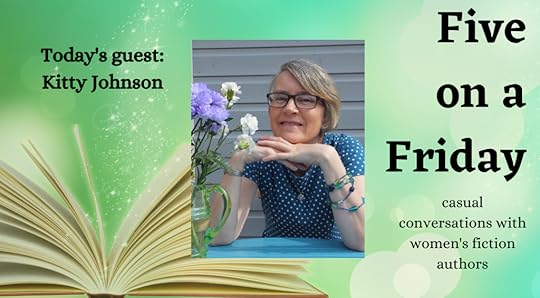
About the book: Friendships, feuds, romance, and unexpected secrets shake up a small community in this sharply funny and compassionate novel by the author of Five Winters.
Frances Mathews doesn’t get out much since her husband died, but that doesn’t stop her from jump-starting a campaign to create a hedgehog highway in Hilltop Place—feeding stations, holes at the bottoms of gates and fences, and wild garden areas for hibernation. To Frances’s delight, her neighbours are on board. Mostly.
There are Jess and Michael, whose marriage is cracking under the unanticipated strain of a recent adoption. And Ryan, a wounded war reporter struggling to connect with his son after a divorce and forced to return to an exasperating parental fold. Plus, a very forthright single mum new to the neighbourhood and an exceedingly proper couple not about to upend their picture-perfect garden for prickly nuisances.
As relationships—from the romantic to the nerve-racking—form and secrets are unearthed, Hilltop Place is threatened in ways that affect them all…unaware hedgehogs included. What Frances and her charitable neighbours soon discover about themselves and each other is hardly what any of them expected.
Welcome, Kitty! Okay, I just have to ask: Why hedgehogs? I feel like there has to be a story here.
Well, they’re cute! But apart from that, I’ve always been a wildlife enthusiast, and I caught the hedgehog bug from Kirsty and Kate, two hedgehog enthusiasts at my local Women’s Institute (WI) group. They’re always talking about the voluntary work they do to take care of hedgehogs and about the benefits to the creatures of hedgehog highways, where a community works together to make life easier for hedgehogs. I went round to Kirsty’s house to witness what she does first hand and was hooked.
Prickly Company feels so organic to the reader—everything just flows, from one character’s story to the next. Nothing extraneous. It seems effortless, but as a writer, I know better. How much planning and plotting did you have to do? Was it all character work, and then you turned the characters loose on the page?
Well actually, Jess, one of the main characters, was originally intended for another novel, but for whatever reason, that book just didn’t work out and I abandoned it. So Jess existed for a good three years before I had the idea for Prickly Company. Before I start writing, I need to know my characters, though I don’t tend to write pages about them, just think about them in my head. Once I start writing and hear how they sound, they come to life. I also need to know my beginning and ending, and three or four touchstones along the way before I can plunge in. I’m not one of those writers who plans everything to the last detail at all, and, to a certain extent the characters and their circumstances do direct me as I write.
I’m always in awe of characters that seem real. Especially children. Writers so often write kids way too old or way too young, but practically never spot on. (I had young children for over 15 years while I was reading to learn about writing, and it was a constant annoyance.) But each of your characters feels authentic—not one of them misses the mark. How do you accomplish this miracle?
Thank you, that’s kind of you to say! I suppose I’m one of life’s observers – I listen in and store things away. It’s probably also down to life experience – as you get older, you have more of that to draw on!
The initial conflict we meet as readers is that of Jess and her husband, who have secondary infertility and are bringing an adoptive child into their home. You have not been through infertility yourself, so what was it that made you choose this as the primary struggle for one of your central characters?
I’ve always been interested in identity and I devour programmes about adoption or people trying to find out about their natural parents. Growing up I often felt very different to the rest of family – so perhaps it has something to do with that! Because I was older when I wanted to start a family, I used fertility treatment to have my son, and before that I did – for a brief period – try to adopt. But as I say, adoption has always been something that interests me.
It speaks well of you as a human being! And so does the topic of my last question. Some of your earlier fiction is short, graded readers for older English learners. How do you think that experience shaped you moving into mainstream fiction?
All writing is excellent experience, and writing those books also familiarised me with the publishing process – getting and responding to feedback, doing edits, working to deadlines etc. That’s been enormously helpful. Writing using limited vocabulary and grammar was an agreeable challenge that required me to constantly think of different ways to say what I wanted to say, and yes, I suppose that’s a useful tool in my writing armoury!
That’s a wrap for this edition of Five On A Friday. Go grab a copy of Kitty Johnson’s Prickly Company from Amazon or Bookshop.org!
May 10, 2024
Happy birthday to A Song For The Road!
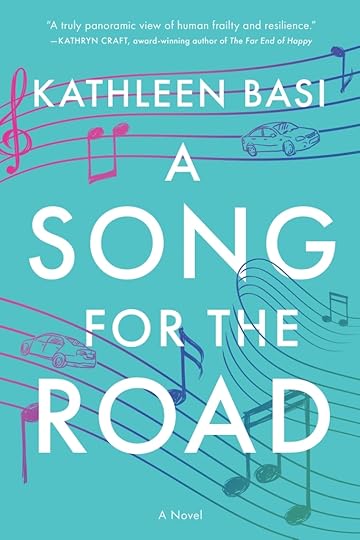
Hi, all! Long time, no see. I’m stretched pretty thin these days with a college kid, two over-involved high schoolers, and a middle schooler, plus writing and revising and writing more. There are more books in the hopper–I promise–but getting the “right” one for the market is proving a longer process than any of us would like!
But I wanted to pop in today briefly to mark the third birthday of my first book baby, A Song For The Road. As I wrote on Substack, third birthdays are a big deal in my family, and we’re celebrating the occasion with a weeklong Kindle sale. Just to make things sweeter, it coincides with Mother’s Day. You can pick up the Kindle edition of A Song For The Road for $1.99 through Tuesday, May 6th. And Kindle books can, in fact, be gifted, so… there you go. 
For the purists among us, Amazon currently has the paperback edition at almost half off, at $8.17. So there you go!
And since I suspect most of my blog readers have already bought and read my book… if you are inclined to give a gift to THIS book, boy, and special needs mother… a social media share of the sale would be a lovely (and free!) one.  (Here’s one for Facebook and one on Instagram.)
(Here’s one for Facebook and one on Instagram.)
Signing off to finish swimming the riptide of Maycember…
February 15, 2024
Book review: Saving Us

Environmental stewardship and climate have long been high, high priorities for me. That is because of my Christian faith and because nature is where I find God and myself and all peace that can be found. But it’s also because I have experienced the damage human beings can do to each other through thoughtless misuse of the natural world.
I’ve written about this before (and at length), but in a nutshell, this is our story. We thought our infertility was a function of polycystic ovaries—and I remain on metformin to this day to treat that—but what ended up allowing us to have children was… are you ready for this? A water filter.
After nearly 3 years of work on my health, my husband encountered, through his job promoting research, studies that showed correlation, and later causation, between alachlor, diazanon, and atrazine in the water supply where we live and suppression of MALE fertility.
It’s really quite jarring to experience in one’s own body and soul how concrete and substantial the impact of human behaviors on nature can be.
For this reason, pushback on environmental policy is one of the things in today’s toxic political environment that makes me COMPLETELY INSANE.
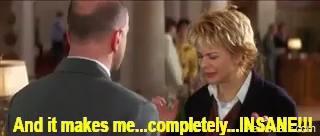
I want so desperately for us as human beings to fix this.
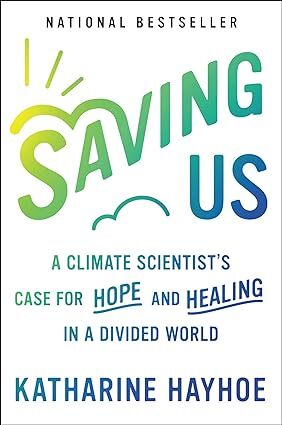
So of course, when I heard about Saving Us: A Climate Scientist’s Case for Hope And Healing, I was going to read it.
And the first thing I learned was that everything I want to do to communicate with people is useless, because those who resist most strongly are not reachable, for a host of reasons psychological, tribal, and even evolutionary. This was slightly demoralizing, I have to admit.
Katharine Hayhoe instead wants us to recognize that it’s not climate change we necessarily need to talk about. If you live in a place where there isn’t enough water, then you work with people on how to manage water and come up with ways to conserve—which is what we need to do in the first place. If you are talking to a person who values saving money, you gush about the savings you get from using solar–which accomplishes the goal of reducing fossil fuels. It doesn’t matter if they agree with you, she seems to say, if you get the job done.
Browbeating, in other words, is unproductive. Looking for values you hold in common and then sharing ways you have discovered to honor those values is the way to go.
The first half of the book really is about breaking down all the problems. It was news to me that biofuel like ethanol actually produces more carbon in the processing than it saves in the burning. Uh-oh.
She also—dishearteningly—points out something I didn’t want to hear from someone who’s actually studied the matter. Namely, that no matter what we all do as individuals, it won’t tip the scales, because it’s the structures that have to change. The biggest sources of carbon are things like airplanes.
But then she starts showing solutions that are already under development. A company called Renewable Energy Group converts agricultural waste and cooking oil from restaurants into diesel fuel. There are big forward strides in electric powered boats and airplanes. Iowa State University has developed “biochar,” which is basically pure carbon that, when applied to soil, acts as a near-miraculous fertilizer. Putting carbon back in the soil, where it came from and where it’s supposed to be, is not just possible, it provides huge benefits to farmers.
And so on and so on. By the time she finished laying out all the possibilities and how they will actually save money once implemented, I thought, “Holy cow, there IS hope.”
Hayhoe also confirms, anecdotally at least, something I have suspected for a long time—that even if your personal actions can’t fix the world, doing ONE thing to be more sustainable gives you a sense of empowerment and leads you to seek out others—and often changes people who are lukewarm about environmental stewardship into enthusiasts.
Katharine Hayhoe is very effective at what she does. Her stories of connecting with people and making a difference on this topic inspire me. I am less confident in my own ability.
Still, here I am, combining book review with personal witness of my own, in hopes of being one of the people putting a hand on the rock at the top of the hill, as she calls it, and giving it my own little push to start the ball rolling.
Here is a sampling of things we do in our family to be good stewards of the environment:
Turn the car off. Collectively, we use 3 billion gallons of gas a year doing absolutely nothing. https://www.youtube.com/watch?v=gHRwwsdalqASolar panels. In 2023 our family produced 104% of our electric usage.Battery-powered lawn mower.Reuse dishwater to water outdoor flowers (and veggies).Cloth shopping bags for every grocery and Target run.Combining trips and walking. Target is across the street from my kid’s school. I mean, it’s a big street and Target is the other end of the parking lot and the mall. So across the street means about 3/4 of a mile. But I will go early for pickup, park, and then walk to Target and back. Once, when I had too much stuff to carry, I did it the opposite direction: parked at Target, did the shopping, walked over to collect the kids, and we all walked back. People think I’m nuts, but when I was visiting Chicago it was very clear to me that the only reason we think we have to drive everywhere is because there’s parking everywhere. When you go to Chicago, you park in one place and you walk. We’re all capable of this. My husband routinely walks downtown to the bank instead of driving on his lunch break.Homemade laundry detergent, so we don’t have to keep buying more big plastic bottles.October 6, 2023
Five on a Friday with Rachel Stone
One perk of being a published author is how many other authors I get to “meet.” We all hear about the big, flashy books by big-name authors, but there are a host of gems that may never cross our paths. I get to see some of those books these days as I help other authors, and I thought I’d use my little platform to feature some stories I’ve really enjoyed.
Today, I’m thrilled to introduce Rachel Stone, author of The Blue Iris, a positively gorgeous book which released this week and which I had the privilege of reading in advance.

Welcome, Rachel! Let’s talk ensemble pieces–stories with half a dozen major characters, all of whom have a character arc that tugs on that of other characters. I tried to write a novel like that and failed. But you’ve managed it! All the characters are so deeply developed, and yet none of them take center stage. How do you develop a story like this?
 Available at Amazon and Bookshop.org
Available at Amazon and Bookshop.orgIn my case, sort of by accident! The first draft had only one main arc (Tessa’s). The secondary characters were coming through more vividly than expected though, and it was actually my developmental editor who identified it as an ensemble piece—even though it needed a LOT more work to bring that out effectively. I had to decide whether to dig deeper into the other characters to get it there, or scale them back and let this story be Tessa’s—which would likely have been the easier, more rational choice all around, from revisions to pitching it to landing the book deal.
But those secondary characters just kept getting louder. I knew the ensemble aspect was the heart of the book, even though the idea of rewriting it that way was completely overwhelming! I knew I couldn’t ask the reader to invest in an ensemble unless every character earned their time on the page in such a way that the story didn’t feel whole without them. It took a LOT of revising and rebalancing until I felt I’d done each of them justice, in relation to the overall story and as individuals.
I’m a sucker for great characters, and yours leap off the page. How did you intertwine these characters so tightly that every one seems to develop in every scene, even when it’s not “their” scene?
I spent a lot of time sitting in the other characters’ headspaces until they felt as real and layered to me as Tessa did. The key, I believe, was to reach the point where they all felt like main protagonists. I did various exercises to help with this, like writing out their private journal entries, letters they’d never send, letters to me about why I was all wrong about them (this article by Caroline Leavitt was wonderful for getting started).
From there, I began tackling how their journeys connected. My editor warned me the first question I’d get when pitching was: “why so many points of view? Why not just Tessa’s?” So I approached each scene by flipping that question on its head: why not these different points of view? Why this voice here, instead of Tessa’s? Each character had to be established vividly and distinctly, but the bigger the ensemble, the less room you have in which to achieve that. Every move a character made, every word they spoke had to do heavy lifting on as many fronts as possible, because there just wasn’t enough space to pull it off otherwise.
The Blue Iris is an open-air flower shop in Toronto. You worked in a similar market, right? How much of what we read in the book is based on your experiences?
I did! During my academic breaks over seven years, I worked at a real flower market that inspired the setting of the Blue Iris. I re-imagined many aspects of course, but the intricacies—buying plant inventory, tips and tricks for conditioning flowers, the day-to-day inner workings—are all elements I learned on the job.
Many of Tessa’s recollections in the first chapter as she returns to the market after many years are also based on my own memories of walking past the real one with my mother as a child. And the scene where characters are trapped inside the walk-in flower refrigerator, in the pitch darkness, while soaking wet? That really did happen to me! My experience while in there was far less eventful than in the book, though. I was stuck in there for only about five seconds, and in that time I managed to knock over a flat of blueberries, which went flying. For the next couple of days, customers kept bringing their bouquets to the counter and all these berries were falling out!
That’s hilarious. And also terrifying. In high school I was in a play and had to hide in a coffin. One day they closed it on me. I am still not sure I’ve recovered. But I digress! The Blue Iris is chock full of incredible beauty–both of situation and some simply gorgeous writing.
At the same time, there’s a lot of rough, really earthy content, too–language, men being coarse, etc. Talk to me about the decision to include such a breadth of human experience in it.
Thank you for such kind words! I’ve always been fascinated by dualities, the idea that two things can be true at once, and the flower market setting was so rich in possibilities for exploring this. On one hand, you have gorgeous blooms overflowing everywhere you look, and meanwhile just hours earlier there was nothing in that space but rusty, waterlogged shelving and curse words flying all over the place.
I’ve learned that things can’t always be taken at face value; a gorgeous presentation isn’t necessarily indicative of depth or integrity. Coarse edges can house the purest intentions. In general, the most exquisite, affecting moments in my life to date have all emerged from the roughest of times. For me, the Blue Iris was the perfect way to explore and celebrate that.
That’s so true, and it opens up a burning question. You and I share a common world view and, I suspect, writing goals. Namely, we are both Catholic, but neither of us writes religious fiction. You and I have spent some time talking privately about the intersection of our religious beliefs and writing about the world realistically. Was this story particularly difficult to write because of that juxtaposition?
It was definitely a hurdle I faced early on, in that I wanted my characters to feel completely real and pull at you, but there was the rather horrific notion lurking over my shoulder that someday people I know were going to read the book, and they might assume my characters’ arcs reflect my own reality or choices (and judge me accordingly). I think a lot of writers struggle with this, especially early on.
The trouble with this line of thinking was, I ended up with a first draft that one editor referred to as “entirely afraid.” I’d filtered out every aspect that made those characters compelling: their innermost wants, their sexuality, their mistakes and most shameful secrets, the way they’d naturally speak. If I wanted them to feel entirely human, I had to be willing to put their varied, very human elements on the page. Sharing art in any form always leaves you open to judgment, but the reality is it’s hard enough getting a whole novel to hang together when you’re making everything up; trying to match reality would be like doing a jigsaw puzzle using pieces from a different box! You have to have faith that most readers understand that, and shift the focus towards making those characters as varied and unique as real people are.
Well, my hat is off to you, because you really accomplished what you set out to do. Thanks for taking time to visit on Five on a Friday!
Readers, check out The Blue Iris at Amazon or Bookshop.org—or ask at your local bookstore!
*Note: This post contains affiliate links.
May 5, 2023
The Long Way Back
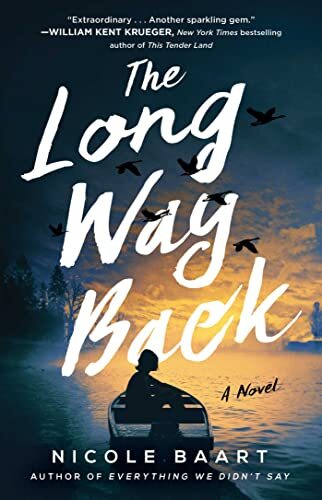 Preorder at Amazon or Bookshop.org
Preorder at Amazon or Bookshop.orgI was late to the Nicole Baart party. When I read my first of her books, I was gobsmacked. “How have I never come across her before?” I asked.
Well, she’s now on my must-read list, and her newest book, The Long Way Back, is coming out in just a few short weeks.
When you pick up a book written by Nicole Baart, you know you’re going to get an intimate, deeply personal story about strong, empathetic women. Women who feel a lot like you and the women you know, whose anxieties and concerns mirror your own.
You also know she’s going to shine a light on serious, meaty questions that echo the real world. But she’s going to do it in a way that centers the dignity and complexity of humanity. You know you’re going to reach the end with a full heart and a stronger appreciation for the beauty of life in this precious world.
Nicole Baart just keeps getting better and better. With “The Long Way Back,” she digs deeper than ever before, tackling social media fame, the disappearance of a teenage child, and darker forces ripped from the headlines.
In part 1, we meet Charlie, a single mother trying to do everything right, who’s suddenly been faced with every parent’s worst nightmare: a missing child, authorities who believe her responsible, and the conviction that they are right, even if not in the way they suspect.
Part 2 belongs to Eva, as we learn what actually happened to her. As she grapples with her first confrontation with evil, the humanity of the people caught within its snare makes everything messier than black and white.
Part 3, we are along for the ride as the two women’s stories converge in a climax that is easy to envision seeing on the news.
This is compulsive reading that unfolds not just through narrative, but through old Instagram posts (plus the story behind them), online articles, and college essays. It’s brilliant, structurally. The back-and-forth illuminates relationships, reveals unexpected plot points, and ties the book together in a way that reflects the nuance and complexity of the real world. You will have trouble putting this down. You may find yourself wishing the real-world versions of the forces at play in these pages could be dealt with as neatly. But you will be glad you went on this journey with Charlie and Eva.
I was lucky enough to get an advance peek at this book via Netgalley, but I’ll be buying it for keeps, and quite possibly gifting it, too.
March 13, 2023
My Take on “Spare”
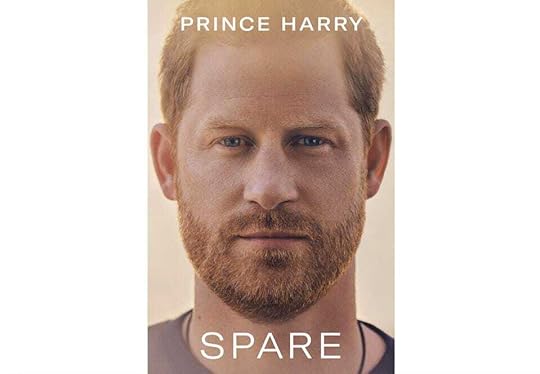 Spare, available on Amazon and Bookshop.org
Spare, available on Amazon and Bookshop.orgOK, I will admit it: I am fascinated with the British royal family. Not nearly as much as some–I never watched the weddings, for instance, not for lack of interest, but because I really don’t have time–and I’ve never bought a magazine with a royal on the cover. After reading Spare, I’m glad of that latter.
But I’ve been fascinated by them nonetheless–in part because of a book I’ve been working on for years that incorporates a “royal” element–and especially with Harry and Meghan. I think it is because they feel so real and approachable. They put a down-to-earth face on what always seemed like a fairy tale. They feel like people I could invite over to dinner and have a normal conversation with.
I watched the Oprah interview; I watched the Netflix special. And when the book Spare came out a few weeks ago, of course I was going to read it. But my to-read list is long and it took a while to get to the top.
In the interim, I heard and read a lot of the chatter around it. I was actually kind of surprised by how, well, mean, some of the podcasters were. But I will also admit that their jaded comments influenced me going into the book. I guarded my heart for a while in the reading, in other words.
The underlying threads that tie this memoir together are how the death of Princess Diana impacted Harry–who was never allowed, let alone taught how, to grieve properly; the status as “spare” in his family, and how those two things were manipulated, exacerbated, and used by a nefarious tabloid press in the UK.
Basically, the criticisms I heard were:
“He’s one of the richest, most privileged guys in the world; how dare he whine for a whole book?”
“He basically admitted he’s illiterate, so all this flowery description in the book by the ghost writer is ridiculous.”
“Everybody hates the press, but come on.”
“For someone who claims to hate the press, he’s seeking an awful lot of attention.”
“How can you throw your family under the bus like that?”
So I’m writing today to share my thoughts on those subjects after reading the whole book.
On the rich, privileged whiner: Harry does not come across as a person who really had any interest in being rich and privileged. I mean, everyone who writes their own story is going to cast themselves as the hero, but unless he’s flat out lying, a guy who lives in the basement apartment with low ceilings, etc.; a guy who hid in the trunk to escape attention; a guy who spent lots of time in Africa to escape the press and slept outside; a guy who worked in the Outback; a guy who worked for years to get into the military and kept begging to be sent back to war–this is not a guy who was looking for a posh, easy ride. He strikes me as a guy who was saddled with a situation that crushes people and literally has no way to escape, because of who his dad is. Also, unless he’s flat out lying, he never really had money of his own; he only got what his dad gave him. Which, I totally admit, was enough to cover luxury trips I could never afford. But, given the descriptions of his actual apartment when he reached adulthood, sounds like there was a big gap between ordinary life and fabulous trips/ceremonial duties.
Illiterate: The people who said this said, “He admitted he hates reading.” Well, actually, that’s not what he said. What he said was, he wasn’t a fabulous student, and in the years after his mom died, he tried hard to avoid time alone and in the quiet, where his thoughts might come out to get him, and reading books was the epitome of both of those. This does not equal illiterate. Come on, people.
On the press: What Harry describes in the book is an intolerable way to live. Any one of us who experienced what he’s experienced would have a nervous breakdown. Imagine the trauma of losing your mom at age 12, knowing the cause was the paparazzi, and then being retraumatzied every day of your life by them doing the same thing to you–and then stepping it up when you finally find someone who helps you heal. And, unless he’s lying, the tabloids (some of which, at least, I don’t know how many, were owned by Rupert Murdoch, so there’s that) made up north of 50% of what we heard about him. It’s a legitimate beef.
On seeking attention: I admit I had this thought too, although in a more “huh, I’m curious as to why” rather than judgment. But it actually came to make sense to me. Given that he got cut off by his father, AND the paparazzi persecution and tabloid false narratives constructed around his wife haven’t changed, all of which requires gargantuanly expensive security, it makes sense to me that he’d say, “Hey, I need to support myself; they won’t let me make a living serving in the military anymore, and I need to support my family. Why not harness the public fascination to earn an income?”
On the family: Yes, this one I get. How can that family ever heal after something like this? I would guess that if there are distortions of reality in the book, they most likely live here, not out of bad will, but because we all see our own side more clearly than anyone else’s. OTOH, that is one seriously dysfunctional family and they don’t seem to have any interest in doing what is necessary to fix it. 100%, it makes sense to remove oneself from that situation, even if it means sacrificing family closeness. (If you can call it that.) Whether it’s moral to go public with all of it is a different question, but the complexities behind that discernment take into account all the things above, and I wouldn’t tell him he was wrong to discern as he did.
So there you go. My long-winded take on a fascinating read. Who else has read it? Surely we can have a spirited discussion on this cultural phenomenon. 
March 8, 2023
“Wicked,” Gregory Maguire

“Wicked” is a cultural phenomenon, and with a few exceptions (Marvel, Star Wars, Harry Potter), I am terrible at keeping up with cultural phenomena. I tried to read it a few years ago and found the early chapters too… let’s call it “earthy”… for my comfort.
I don’t know the musical, either, despite being a huge Broadway fan and–now–knowing Idina Menzel very, very well, because I also have a teenage daughter who remains obsessed with Anna and Elsa. (Case in point: as I wrote this, she was upstairs playing the video of Disney Harmonious, hosted by Menzel, at top volume.) But when you have 4 kids and they’re small, you have neither the time nor the money to drive two hours to see the Broadway shows when they come through.
However, this spring my family is getting older and I decided to go see “Wicked” with some friends. And so I decided it was time to take another whack at the book, so I’d be able to compare the two.
This time around, the earthiness was still hard to get through, but when Elphaba transitioned to college and met Glinda, I caught my stride.
I liked the reimagining of a familiar story. Glinda as a ditzy, shallow socialite; the Wizard as a toxic influence; the magical setting shown to have a dark underbelly. Every so often, a glimpse of The Wizard of Oz would peek through–the first being the lion cub destined to become the Cowardly Lion. Speaking of capital-L Lion, the through line about the treatment of Animals was among the most interesting innovations Maguire came up with, in my eyes. I would have liked to have seen it explored more thoroughly, but maybe he does that in the rest of the series.
It was interesting to see how Elphaba’s sensitivity to water was simply taken for granted, never explained, simply part of the landscape. Elphaba’s lack of curiosity about herself, her outwardly dispassionate approach to life, which conceals a deep passion she never really acknowledges–commitment to loved ones, even when she thinks they’re totally off base; a commitment to justice–even though she doesn’t emote, she Emotes.
I’ve been juggling many books at once lately, and it came to a point where this was the one that had the least urgency, but the most desire to see where it was going. I almost expected a different ending to the Witch’s life than the one L. Frank Baum gave us.
Have you read Wicked? How about its sequels? What’s your take?
February 27, 2023
It’s sale time again!
Today (Feb. 27, 2023) only: A SONG FOR THE ROAD is on Kindle sale for $1.99! (Hint: Feel free to share this post.  ) And I promise, I’ll have more book reviews up soon… it’s been quite a year so far!
) And I promise, I’ll have more book reviews up soon… it’s been quite a year so far!
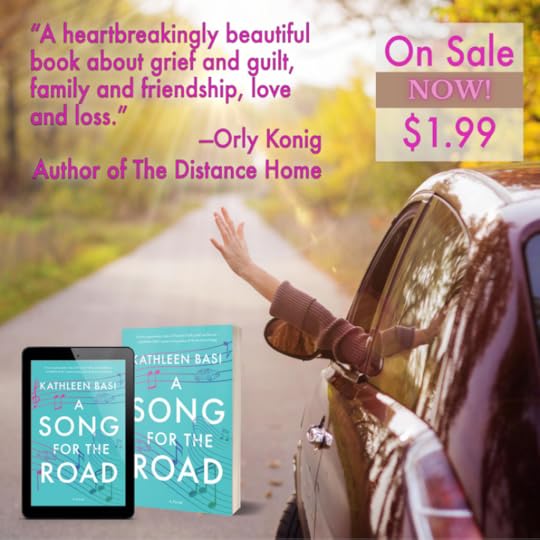
February 13, 2023
Throwback: A Tangled Web
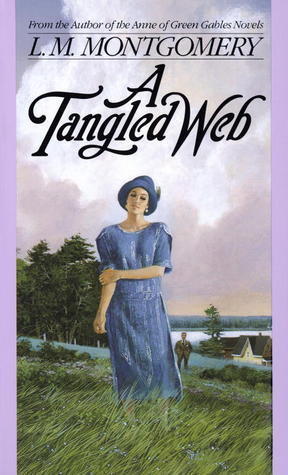 Buy it on Amazon and Bookshop.org
Buy it on Amazon and Bookshop.orgI have loved the Anne and Emily books since the first time I read them, but it took me until now to read this late work of Lucy Montgomery’s. In all her books, she creates a community of vivid characters, all of them quirky and none of them very in tune with their own emotions. But A Tangled Web is a true ensemble piece. I was not convinced I would enjoy it for the first few dozen pages, because the sheer number of characters introduced was a little intimidating. But over the course of the book I became invested in almost all their stories. To see L.M. Montgomery’s world years after Anne and Emily, after World War, was interesting on its own. You get the sense that she’s no longer pulling her punches; she’s reached the maturity to slay the ludicrousness she sees without prettying it up out of fear of what people might think of her.
I loved everything until the last page, when a very ugly N word in the mouth of one of the most ludicrous characters gut punched me… and caused me to question posting the review. I have to admit I don’t understand why she chose that as her ending. But of course I look at it through the eyes of 2023. The rest of the twists and turns, as this vast cast of characters exerts a push and pull on each other, was simply breathtaking. Among my favorites: the “old maid” who decides she can be a mom and own a home without needing to get married to do it and a faithful, kind man who wins the day by being a friend when his loved one cannot handle being loved any other way.



